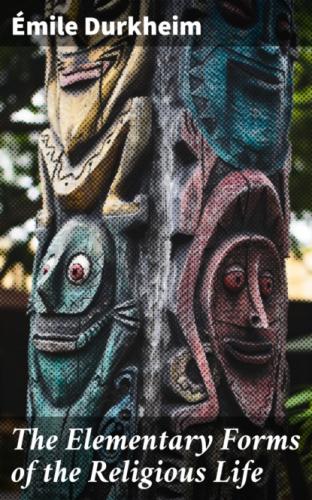Émile Durkheim
The Elementary Forms of the Religious Life
Published by Good Press, 2019
EAN 4057664097941
Table of Contents
INTRODUCTION SUBJECT OF OUR STUDY: RELIGIOUS SOCIOLOGY AND THE THEORY OF KNOWLEDGE
CHAPTER I DEFINITION OF RELIGIOUS PHENOMENA AND OF RELIGION [25]
CHAPTER II LEADING CONCEPTIONS OF THE ELEMENTARY RELIGION I.— Animism
CHAPTER III LEADING CONCEPTIONS OF THE ELEMENTARY RELIGION— continued II.— Naturism
CHAPTER IV TOTEMISM AS AN ELEMENTARY RELIGION History of the Question.—Method of Treating it
BOOK II THE ELEMENTARY BELIEFS
CHAPTER I TOTEMIC BELIEFS The Totem as Name and as Emblem
CHAPTER II TOTEMIC BELIEFS— continued The Totemic Animal and Man
CHAPTER III TOTEMIC BELIEFS— continued The Cosmological System of Totemism and the Idea of Class
CHAPTER IV TOTEMIC BELIEFS— end The Individual Totem and the Sexual Totem
CHAPTER V ORIGINS OF THESE BELIEFS Critical Examination of Preceding Theories
CHAPTER VII ORIGINS OF THESE BELIEFS— end Origin of the Idea of the Totemic Principle or Mana
CHAPTER VIII THE IDEA OF THE SOUL
CHAPTER IX THE IDEA OF SPIRITS AND GODS
BOOK III THE PRINCIPAL RITUAL ATTITUDES
CHAPTER I THE NEGATIVE CULT AND ITS FUNCTIONS THE ASCETIC RITES
CHAPTER II THE POSITIVE CULT I.— The Elements of the Sacrifice
CHAPTER III THE POSITIVE CULT— continued II.— Imitative Rites and the Principle of Causality
CHAPTER IV THE POSITIVE CULT— continued III.— Representative or Commemorative Rites
CHAPTER V PIACULAR RITES AND THE AMBIGUITY OF THE NOTION OF SACREDNESS
THE
ELEMENTARY FORMS OF
THE RELIGIOUS LIFE
INTRODUCTION SUBJECT OF OUR STUDY: RELIGIOUS SOCIOLOGY AND THE THEORY OF KNOWLEDGE
In this book we propose to study the most primitive and simple religion which is actually known, to make an analysis of it, and to attempt an explanation of it. A religious system may be said to be the most primitive which we can observe when it fulfils the two following conditions: in the first place, when it is found in a society whose organization is surpassed by no others in simplicity;[1] and secondly, when it is possible to explain it without making use of any element borrowed from a previous religion.
We shall set ourselves to describe the organization of this system with all the exactness and fidelity that an ethnographer or an historian could give it. But our task will not be limited to that: sociology raises other problems than history or ethnography. It does not seek to know the passed forms of civilization with the sole end of knowing them and reconstructing them. But rather, like every positive science, it has as its object the explanation of some actual reality which is near to us, and which consequently is capable of affecting our ideas and our acts: this reality is man, and more precisely, the man of to-day, for there is nothing which we are more interested in knowing. Then we are not going to study a very archaic religion simply for the pleasure of telling its peculiarities and its singularities. If we have taken it as the subject of our research, it is because it has seemed to us better adapted than any other to lead to an understanding of the religious nature of man, that is to say, to show us an essential and permanent aspect of humanity.
But this proposition is not accepted before the raising of strong objections. It seems very strange that one must turn back, and be transported to the very beginnings of history, in order to arrive at an understanding of humanity as it is at present. This manner of procedure seems particularly paradoxical in the question which concerns us. In fact, the various religions generally pass as being quite unequal in value and dignity; it is said that they do not all contain the same quota of truth. Then it seems as though one could not compare the highest forms of religious thought with the lowest, without reducing the first to the level of the second. If we admit that the crude cults of the Australian tribes can help us to understand Christianity, for example, is that not supposing that this latter religion proceeds from the same mentality as the former, that it is made up of the same superstitions and rests upon the same errors? This is how the theoretical importance which has sometimes been attributed to primitive religions has come to pass as a sign of a systematic hostility to all religion, which, by prejudging the results of the study, vitiates them in advance.
There is no occasion for asking here whether or not there are scholars who have merited this reproach, and who have made religious history and ethnology a weapon against religion. In any case, a sociologist cannot hold such a point of view. In fact, it is an essential postulate of sociology that a human institution cannot rest upon an error and a lie, without which it could not exist. If it were not founded
